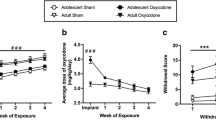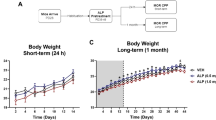Abstract
Rationale
Drug use and abuse is thought to be a function of the balance between its rewarding and aversive effects, such that the rewarding effects increase the likelihood of use while the drug’s dissociable aversive effects limit it. Adolescents exhibit a shift in this balance toward reward, which may ultimately lead to increased use. Importantly, recent work shows that adolescents are also protected from the aversive effects of many abusable drugs as measured by conditioned taste avoidance (CTA). However, such effects of methylphenidate (MPH, widely prescribed to adolescents with ADHD) have not been characterized.
Objectives
The effect of age on MPH-induced CTA was assessed. In addition, MPH-induced changes in brain-derived neurotrophic factor (BDNF) activity in the insular cortex (IC) and central nucleus of the amygdala (CeA), known to be important to CTA, were examined and related to CTAs in adolescents and adults.
Methods
CTAs induced by MPH (0, 10, 18, and 32 mg/kg) were assessed in adolescent (n = 34) and adult (n = 33) male Sprague Dawley rats. Following MPH CTA, IC and CeA tissue was probed for differences in BDNF and tropomyosin-related kinase receptor-B (TrkB) using Western blots.
Results
Blunted expression of MPH CTA was observed in the adolescents versus adults, which correlated with generally attenuated adolescent BDNF/TrkB activity in the IC, but the drug effects ran contrary to the expression of CTA.
Conclusions
Adolescents are protected from the aversive effects of MPH versus adults, but further work is needed to characterize the possible involvement of BDNF/TrkB.




Similar content being viewed by others
References
Anderson RI, Varlinskaya EI, Spear LP (2010) Ethanol induced conditioned taste aversion in male Sprague Dawley rats: impact of age and stress. Clinical and Experimental Research, Alcoholism 34:2106–2115
Anderson RI, Agoglia AE, Morales M, Varlinskaya EI, Spear LP (2013) Stress, kappa manipulations, and aversive effects of ethanol in adolescent and adult male rats. Neuroscience 249:214–222
Badanich KA, Adler KJ, Kirstein CL (2006) Adolescents differ from adults in cocaine conditioned place preference and cocaine-induced dopamine in the nucleus accumbens septi. Eur J Pharmacol 550:95–106
Barki-Harrington L, Belelovsky K, Doron G, Rosenblum K (2009) Molecular mechanisms of taste learning in the insular cortex and amygdala. In: Reilly S, Schachtman TR (eds) Conditioned taste aversion. Oxford University, New York, pp 341–363
Belluzzi JD, Lee AG, Oliff HS, Leslie FM (2004) Age-dependent effects of nicotine on locomotor activity and conditioned place preference in rats. Psychopharmacology 174:389–395
Brockwell N, Eikelboom R, Beninger R (1991) Caffeine-induced place and taste conditioning: production of dose-dependent preference and aversion. Pharmacol Biochem Behav 38:513–517
Castillo DV, Escobar ML (2011) A role for MAPK and PI-3K signaling pathways in brain-derived neurotrophic factor modification of conditioned taste aversion retention. Behav Brain Res 217:248–252
Castillo DV, Figueroa-Guzmán Y, Escobar ML (2006) Brain-derived neurotrophic factor enhances conditioned taste aversion retention. Brain Res 1067:250–255
Chang MS, Arevalo JC, Chao MV (2004) Ternary complex with Trk, p75, and an ankyrin‐rich membrane spanning protein. J Neurosci Res 78:186–192
Cobuzzi J, Siletti K, Hurwitz Z, Wetzell B, Baumann M, Riley A (2013) Age differences in (±)3,4-methylenedioxymethamphetamine (MDMA)-induced conditioned taste aversions and monoaminergic activity. Dev Psychobiol. doi:10.1002/dev.21132
dela Peña I, Ahn HS, Choi JY, Shin CY, Ryu JH, Cheong JH (2011) Methylphenidate self-administration and conditioned place preference in an animal model of attention-deficit hyperactivity disorder: the spontaneously hypertensive rat. Behav Pharmacol 22:31–39
Djakiew D, Pflug B, Dionne C, Onoda M (1994) Postnatal expression of nerve growth factor receptors in the rat testis. Biol Reprod 51:214–221
Doremus-Fitzwater TL, Varlinskaya EI, Spear LP (2010) Motivational systems in adolescence: possible implications for age differences in substance abuse and other risk-taking behaviors. Brain Cogn 72:114–123
Escobar ML, Bermúdez-Rattoni F (2000) Long-term potentiation in the insular cortex enhances conditioned taste aversion retention. Brain Res 852:208–212
Fayard B, Loeffler S, Weis J, Vögelin E, Krüttgen A (2005) The secreted brain‐derived neurotrophic factor precursor pro‐BDNF binds to TrkB and p75NTR but not to TrkA or TrkC. J Neurosci Res 80:18–28
Freeman KB, Riley AL (2009) The origins of conditioned taste aversion learning: an historical analysis. In: Reilly S, Schachtman TR (eds) Conditioned taste aversion: behavioral and neural processes. Oxford University, New York, pp 9–33
Fryer RH, Kaplan DR, Feinstein SC, Radeke MJ, Grayson DR, Kromer LF (1996) Developmental and mature expression of full‐length and truncated TrkB, receptors in the rat forebrain. J Comp Neurol 374:21–40
Hayashi T, McMahon H, Yamasaki S, Binz T, Hata Y, Südhof T, Niemann H (1994) Synaptic vesicle membrane fusion complex: action of clostridial neurotoxins on assembly. EMBO J 13:5051–5061
Hunt T, Amit Z (1987) Conditioned taste aversion induced by self-administered drugs: paradox revisited. Neurosci Biobehav Rev 11:107–130
Hurwitz Z, Merluzzi A, Riley A (2012) Age-dependent differences in morphine-induced taste aversions. Dev Psychobiol 55:415–428
Hurwitz Z, Cobuzzi J, Merluzzi A, Wetzell B, Riley A (2013) Prepubertal Fischer 344 rats display stronger morphine-induced taste avoidance than prepubertal Lewis rats. Dev Psychobiol. doi:10.1002/dev.21176
Infurna RN, Spear LP (1979) Developmental changes in amphetamine-induced taste aversions. Pharmacol Biochem Behav 11:31–35
King H, Riley A (2013) A history of morphine-induced taste aversion learning fails to affect morphine-induced place preference conditioning in rats. Learn Behav 41:433–442
Kohut SJ, Decicco-Skinner KL, Johari S, Hurwitz ZE, Baumann MH, Riley AL (2012) Differential modulation of cocaine’s discriminative cue by repeated and variable stress exposure: relation to monoamine transporter levels. Neuropharmacology 63:330–337
Kolbeck R, Jungbluth S, Barde YA (1994) Characterisation of neurotrophin dimers and monomers. Eur J Biochem 225:995–1003
Kong H, Boulter J, Weber JL, Lai C, Chao MV (2001) An evolutionarily conserved transmembrane protein that is a novel downstream target of neurotrophin and ephrin receptors. J Neurosci 21:176–185
Kubista H, Edelbauer H, Boehm S (2004) Evidence for structural and functional diversity among SDS-resistant SNARE complexes in neuroendocrine cells. J Cell Sci 117:955–966
Ma L, Wang DD, Zhang TY, Yu H, Wang Y, Huang SH, Lee FS, Chen ZY (2011) Region-specific involvement of BDNF secretion and synthesis in conditioned taste aversion memory formation. J Neurosci 31:2079–2090
Martínez-Moreno A, Rodríguez-Durán LF, Escobar ML (2011) Late protein synthesis-dependent phases in CTA long-term memory: BDNF requirement. Front Behav Neurosci 5:1–6
Merluzzi A, Hurwitz Z, Briscione M, Cobuzzi J, Wetzell B, Rice K, Riley A (2013) Age-dependent MDPV-induced taste aversions and thermoregulation in adolescent and adult rats. Dev Psychobiol. doi:10.1002/dev.21171
Moguel-González M, Gómez-Palacio-Schjetnan A, Escobar ML (2008) BDNF reverses the CTA memory deficits produced by inhibition of protein synthesis. Neurobiol Learn Mem 90:584–587
National Research Council (2003) Guidelines for the care and use of mammals in neuroscience and behavioral research. National Academy, Washington, D.C.
National Research Council (2011) Guide for the care and use of laboratory animals. National Academy, Washington, D.C.
Neubrand VE, Cesca F, Benfenati F, Schiavo G (2012) Kidins220/ARMS as a functional mediator of multiple receptor signalling pathways. J Cell Sci 125:1845–1854
Ohira K, Hayashi M (2009) A new aspect of the TrkB signaling pathway in neural plasticity. Curr Neuropharmacol 7:276–285
Palkovits M, Brownstein MJ (1988) Maps and guide to microdissection of the rat brain. Elsevier, New York
Paxinos G, Watson C (2005) The rat brain in stereotaxic coordinates, 5th edn. Academic, San Diego
Peace TA, Singer AW, Niemuth NA, Shaw ME (2001) Effects of caging type and animal source on the development of foot lesions in Sprague Dawley rats (Rattus norvegicus). J Am Assoc Lab Anim Sci 40:17–21
Pflug BR, Onoda M, Lynch JH, Djakiew D (1992) Reduced expression of the low affinity nerve growth factor receptor in benign and malignant human prostate tissue and loss of expression in four human metastatic prostate tumor cell lines. Cancer Res 52:5403–5406
Philpot RM, Badanich KA, Kirstein C (2003) Place conditioning: age related changes in the rewarding and aversive effects of alcohol. Alcohol Clin Exp Res 27:593–599
Riley AL (2011) The paradox of drug taking: the role of the aversive effects of drugs. Physiol Behav 103:69–78
Riley AL, Tuck D (1985) Conditioned taste aversions: a behavioral index of toxicity. Ann N Y Acad Sci 443:272–292
Riley AL, Zellner D (1978) Methylphenidate-induced conditioned taste aversion: an index of toxicity. Physiol Psychol 6:354–358
Sagvolden T (2000) Behavioral validation of the spontaneously hypertensive rat (SHR) as an animal model of attention-deficit/hyperactivity disorder (AD/HD). Neurosci Biobehav Rev 24:31–39
Schramm-Sapyta N, Morris R, Kuhn C (2006) Adolescent rats are protected from the conditioned aversive properties of cocaine and lithium chloride. Pharmacol Biochem Behav 84:344–352
Schramm-Sapyta N, Cha YM, Chaudhry S, Wilson WA, Swartzwelder HS, Kuhn CM (2007) Differential anxiogenic, aversive, and locomotor effects of THC in adolescent and adult rats. Psychopharmacology 191:867–877
Schramm-Sapyta N, Walker Q, Caster J, Levin E, Kuhn C (2009) Are adolescents more vulnerable to drug addiction than adults? Evidence from animal models. Psychopharmacology 206:1–21
Shram MJ, Funk D, Li Z, Lê AD (2006) Periadolescent and adult rats respond differently in tests measuring the rewarding and aversive effects of nicotine. Psychopharmacology 186:201–208
Spear LP (2011) Rewards, aversions and affect in adolescence: emerging convergences across laboratory animal and human data. Dev Cogn Neurosci 1:390–403
Spear LP (2013) Adolescent neurodevelopment. J Adolesc Health 52:S7–S13
Vastola BJ, Douglas LA, Varlinskaya EI, Spear LP (2002) Nicotine-induced conditioned place preference in adolescent and adult rats. Physiol Behav 77:107–114
Verendeev A, Riley AL (2012) Conditioned taste aversion and drugs of abuse: history and interpretation. Neurosci Biobehav Rev 36:2193–2205
Volkow N, Wang G, Fowler J, Logan J, Gerasimov M, Maynard L, Ding Y, Gatley S, Gifford A, Franceschi D (2001) Therapeutic doses of oral methylphenidate significantly increase extracellular dopamine in the human brain. J Neurosci 21:RC121 (1–5)
Wetzell B, Riley A (2012) Adolescent exposure to methylphenidate has no effect on the aversive properties of cocaine in adulthood. Pharmacol Biochem Behav 101:394–402
Wise R, Yokel R, DeWitt H (1976) Both positive reinforcement and conditioned aversion from amphetamine and from apomorphine in rats. Science 191:1273–1275
Zakharova E, Leoni G, Kichko I, Izenwasser S (2009) Differential effects of methamphetamine and cocaine on conditioned place preference and locomotor activity in adult and adolescent male rats. Behav Brain Res 198:45–50
Acknowledgements
The authors would like to thank Nick Watson and Gervaise Henry from the Department of Biology, American University for their input and technical assistance with the Western blot analyses.
Conflict of interest
There are no conflicts of interest.
Author information
Authors and Affiliations
Corresponding author
Additional information
This work was supported by a grant from the Mellon Foundation to ALR and a Dean’s Graduate Research Grant to BBW.
Rights and permissions
About this article
Cite this article
Wetzell, B.B., Muller, M.M., Cobuzzi, J.L. et al. Effect of age on methylphenidate-induced conditioned taste avoidance and related BDNF/TrkB signaling in the insular cortex of the rat. Psychopharmacology 231, 1493–1501 (2014). https://doi.org/10.1007/s00213-014-3500-y
Received:
Accepted:
Published:
Issue Date:
DOI: https://doi.org/10.1007/s00213-014-3500-y




